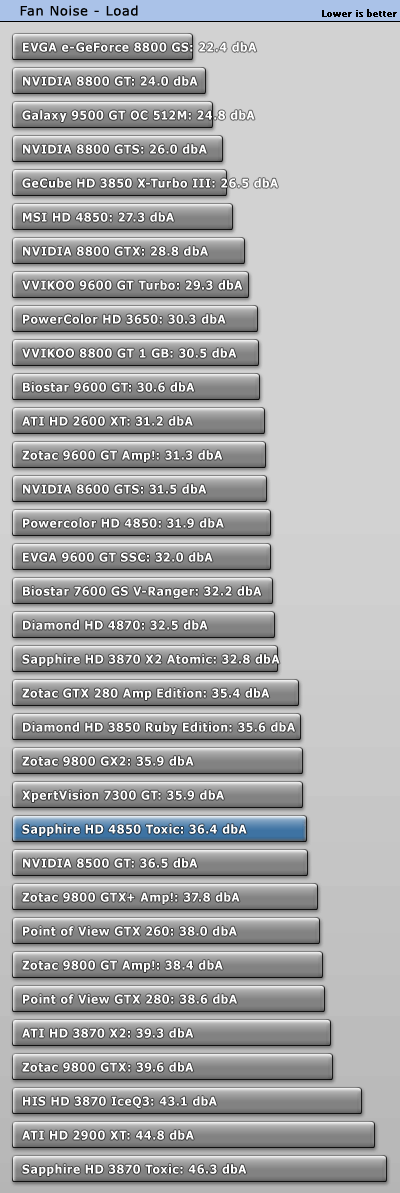 14
14
Sapphire HD 4850 Toxic 512 MB Review
Performance Summary, Perf/W, Perf/$ »Fan Noise
In the past years users would accept everything just to get more performance. Nowadays this has changed with people being more aware of the fan noise and power consumption of their graphic cards.In order to properly test the fan noise a card emits we are using a Bruel & Kjaer 2236 sound level meter (~$4,000) which has the measurement range and accuracy we are looking for.

The tested graphics card is installed in a system that is completely passively cooled. That is passive PSU, passive CPU cooler, passive cooling on the motherboard and Solid-State HDD.
This setup allows us to eliminate secondary noise sources and test only the video card. To be more compliant with standards like DIN 45635 (we are not claiming to be fully DIN 45635 certified) the measurement is conducted at 100 cm distance and 160 cm over the floor. The ambient background noise level in the room is well below 20 dbA for all measurements. Please note that the dbA scale is not linear, it is logarithmic. 40 dbA is not twice as loud as 20 dbA. A 3 dbA increase results in double the sound pressure. The human hearing is a bit different and it is generally accepted that a 10 dbA increase doubles the perceived sound level.
Sapphire has chosen to remove the temperature based fan control mechanism from their cooling solution. The fan will always run at the same speed, no matter if you run an idle system in Antarctica or under full load in the middle of the Saudi Desert. When asked, Sapphire replied that they "noticed that on many systems the problem is that the fan always starts and stops - at different temperatures. So we decided to always run at the same quiet fan speed".
This approach results in one of the noisiest cards under idle. When compared to the reference design HD 4850 the fan is 16.4 dbA noisier in idle - that's over 40x the sound pressure. Under load the margin gets smaller, yet the card cannot compare to the reference design when it comes to fan noise. However, the increased fan speed results in much lower temperatures and higher overclocking potential. Unfortunately power users won't be able to adjust the fan via any software. No matter what fan speed the card wants to run at the fan will always be around 1700 RPM.


Mar 4th, 2025 06:07 EST
change timezone
Latest GPU Drivers
New Forum Posts
- The future of RDNA on Desktop. (62)
- Game performance testing: are all SKUs necessary? (3)
- 1080ti with 0 vram (3)
- High-end build in the 2025 mad world situation (15)
- Windows 11 General Discussion (5772)
- Ryzen Owners Zen Garden (7706)
- It's happening again, melting 12v high pwr connectors (997)
- AWARD-Phoenix Legacy-HOW TO ADD BIOS NVMe M.2 SSD SUPPORT TO OLD MOTHERBOARDS? (0)
- Maxsun RX580 graphics card crashes (3)
- Matrix Deliverance - a fan-made video based on Kingdom Come: Deliverance II game (0)
Popular Reviews
- AMD Radeon RX 9070 Series Technical Deep Dive
- ASUS GeForce RTX 5070 Ti TUF OC Review
- EIZO FlexScan EV4340X Review - A Multitasking Powerhouse
- AMD Ryzen 7 9800X3D Review - The Best Gaming Processor
- be quiet! Pure Base 501 DX Review
- RAWM ES21M Review
- MSI GeForce RTX 5070 Ti Vanguard SOC Review
- MSI GeForce RTX 5070 Ti Ventus 3X OC Review
- ASUS ROG Harpe Ace Mini Review
- MSI GeForce RTX 5070 Ti Gaming Trio OC+ Review
Controversial News Posts
- NVIDIA GeForce RTX 50 Cards Spotted with Missing ROPs, NVIDIA Confirms the Issue, Multiple Vendors Affected (513)
- AMD Plans Aggressive Price Competition with Radeon RX 9000 Series (278)
- AMD Radeon RX 9070 and 9070 XT Listed On Amazon - One Buyer Snags a Unit (260)
- AMD Mentions Sub-$700 Pricing for Radeon RX 9070 GPU Series, Looks Like NV Minus $50 Again (248)
- NVIDIA Investigates GeForce RTX 50 Series "Blackwell" Black Screen and BSOD Issues (244)
- AMD RDNA 4 and Radeon RX 9070 Series Unveiled: $549 & $599 (230)
- AMD Radeon RX 9070 and 9070 XT Official Performance Metrics Leaked, +42% 4K Performance Over Radeon RX 7900 GRE (195)
- AMD Radeon RX 9070-series Pricing Leaks Courtesy of MicroCenter (158)
